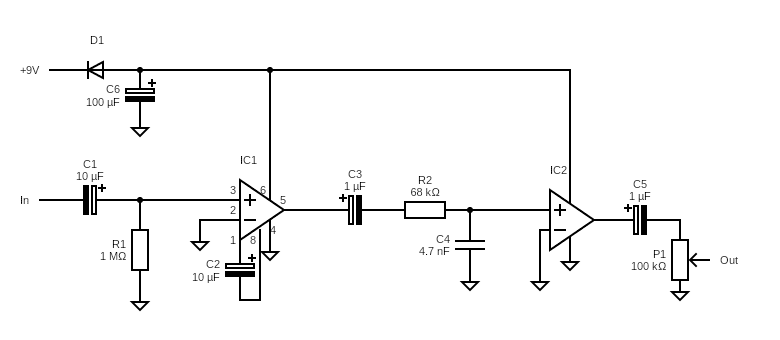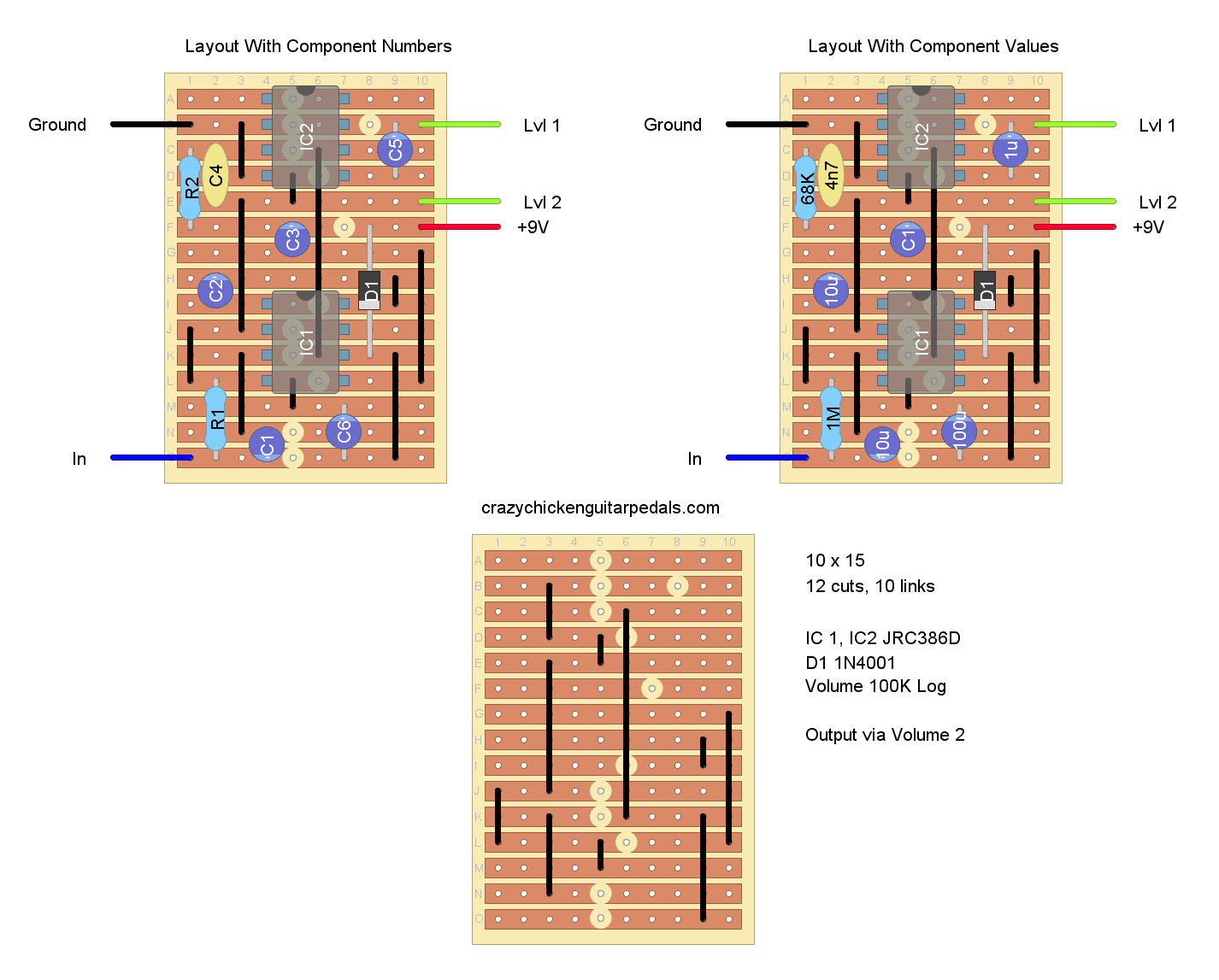The Acapulco Gold by EarthQuaker Devices is a pretty well know single knob distortion pedal. According to EarthQuaker Devices themselves, they’ve modelled this pedal off of a Sunn Model T amplifier turned up to the max. Similar to the Lovelpedal Champ, the single knob on this pedal means the amount of drive is adjusted with the guitar’s volume knob. Turn up the volume on your guitar, get a more distorted sound. Turn it down, and lower the amount of distortion. The single knob on the pedal itself adjusts the volume.
This all makes the Acapulco Gold a super simple to not only operate, but also build. This thing only has two resistors in it and a handful of capacitors, making it an easy guitar pedal to build. There are two op-amps in this build and, somewhat surprisingly, no diodes (other than the reverse polarity diode). All the clipping is coming from those operational amplifiers getting pushed too hard, and they do it well.
EarthQuaker Devices’ Acapulco Gold is a popular DIY pedal because of its simplicity and also because it sounds really good. If you’re a new builder, or even a pedal builder with experience, the Acapulco Gold is one of those guitar pedals that everyone has to build at some point.
So if you haven’t built one yet, read on to find out how.
EarthQuaker Devices Acapulco Gold Wiring Schematic
As usual, before going into the stripboard layout for the Acapulco Gold, here’s the schematic. If you want to try to lay this out on a breadboard or modify it, the schematic below should help you out.
Click on the schematic to enlarge it.
And here’s the bill of materials.
| Notes | ||
|---|---|---|
| R1 | 1M | |
| R2 | 68K | |
| C1 | 10uF | |
| C2 | 10uF | |
| C3 | 1uF | |
| C4 | 4.7nF | |
| C5 | 1uF | |
| C6 | 100uF | |
| IC1, IC2 | JRC386D | I used LM386L |
| P1 | 100K Log | Volume potentiometer |
| D1 | 1N4001 | |
| Jacks, power supply, etc. | Don't Forget | The stuff you usually use. |
As you can see, there’s not really much to this schematic.
The only big note I have is that while the original schematic called for two JRC386D op-amps, I couldn’t track these down. I had read about other builders using LM386L op-amps with good results, so that’s what I went with. They have the same pin configuration as the JRC386D and similar specs. And the pedal still sounds great with them. If you’re having trouble getting the JRC386D op-amps, the LM386L works just fine.
The only other thing of note in the circuit design is the low pass filter made with R2 and C4. This, I assume, is to get the pedal’s natural tone closer to the Sunn Model T’s tone, since this pedal is based on that amp. It takes out a few of the higher frequencies and keeps the distortion ballsy.
With that in mind, feel free to change up the values of R2 and C4 to see what happens with the tone. The spirit of this pedal is adjust the tone via the guitar (hence the lack of tone knob), but if you want it to have a different built in tone, this is where to have a fiddle.
I’ve also seen stripboard layouts for the Acapulco Gold that adds a 1M potentiometer at the start. This allows you to adjust the distortion level of the pedal without having to do it via your guitar’s volume knob.
EarthQuaker Devices Acapulco Gold Stripboard Layout
This is a similar stripboard layout you’ll find over a Tagboard Effects, I’ve made a minor modification to remove the LED from the stripboard, because it’s usually easier to add the LED when wiring the pedal footswitch. The stripboard layout for the Acapulco Gold isn’t terribly crowded, but it’s one less thing to put on the stripboard, making the build even simpler.
As usual, I’ve included a layout with the component numbers (as per the schematic above) if you want to make modifications and with the component values themselves if you just want to follow along.
And if you like this layout, feel free to check out my other stripboard layouts for another project for when you’re finished with this one.
Here’s the stripboard layout:
Click on the diagram to enlarge it.
My Experience Building The EarthQuaker Devices Acapulco Gold
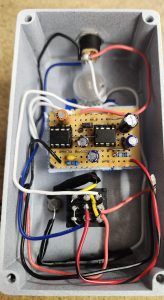 I’m enjoying making these beginner builds. They sound great and they’re relaxing to make, and the Acapulco Gold is no different!
I’m enjoying making these beginner builds. They sound great and they’re relaxing to make, and the Acapulco Gold is no different!
The only funny thing to happen, which was due to my hubris, was not drilling out the enclosure properly, making the enclosure wiring a little… odd. This is a lesson and reminder to “measure twice and cut once” because I put the footswitch up too high in relation to the input and output jacks, meaning the jacks didn’t fit. For now the jacks are wired outside of the enclosure. Oh well. I’m out of enclosures at the moment, so I guess it will be like that for awhile.
Personally, having super tidy enclosure wiring isn’t my biggest strength, and I think my poor drilling meant my internal wiring could have been better as well. I lost patience with it a little bit and I think good enclosure wiring is really about patience. Unfortunately it’s not a virtue I have.
How Does The EarthQuaker Devices Acapulco Gold Sound?
This is a nice little pedal. The style of music I play doesn’t usually use distortion (I usually like overdrive and fuzz), but I can still say this thing sounds great.
As distortion goes, the Acapulco Gold has a smoothness to it. Obviously it distorts the guitar signal, but it doesn’t have a crunch to it like some distortion pedals have. As someone who primarily uses fuzz and overdrive, this is a sound that works well for me. That, of course, is with the volume on the guitar turned all the way up to give the most distortion.
When the guitar’s volume is turned down, the distortion level of the pedal is reduced (as is the design), giving some more subtle distorted sounds that could work across a few genres, not just the really distorted one!
Although there is that low pass filter in the circuit I mentioned, it’s not a super bass-y pedal. The natural tone here is pretty middle of the road, but in a good way; not really treble, not really bass. It’s well balanced.
If you’re looking for a nice and easy distortion, pedal, give the Acapulco Gold a go.
Related posts:
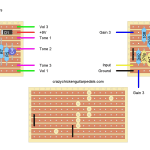 Lovepedal Purple Plexi On Stripboard
Lovepedal Purple Plexi On Stripboard
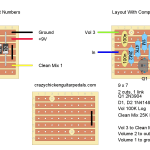 Greer Amps Green Giant On Stripboard
Greer Amps Green Giant On Stripboard
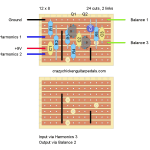 Escobedo Harmonic Jerculator On Stripboard
Escobedo Harmonic Jerculator On Stripboard
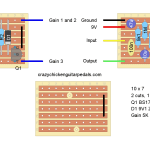 ZVEX Super Hard On On Stripboard
ZVEX Super Hard On On Stripboard
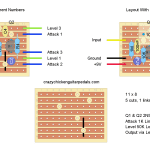 Vox Tone Bender On Stripboard
Vox Tone Bender On Stripboard
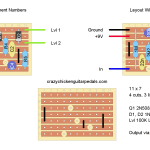 Lovepedal Champ On Stripboard
Lovepedal Champ On Stripboard
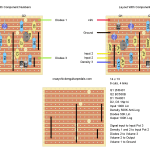 Catalinbread Karma Suture On Stripboard
Catalinbread Karma Suture On Stripboard
 Ibanez Tube Screamer (TS808) On Stripboard
Ibanez Tube Screamer (TS808) On Stripboard
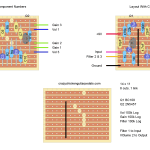 Lumpy’s Tone Shop Lemon Drop On Stripboard
Lumpy’s Tone Shop Lemon Drop On Stripboard
 Colorsound One Knob Fuzz On Stripboard
Colorsound One Knob Fuzz On Stripboard
